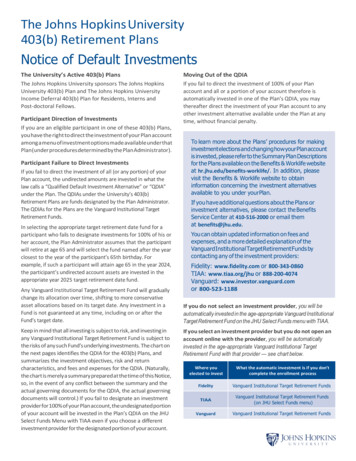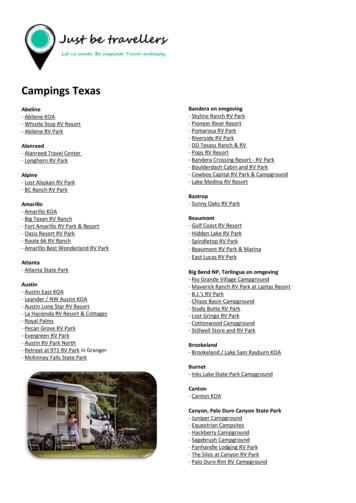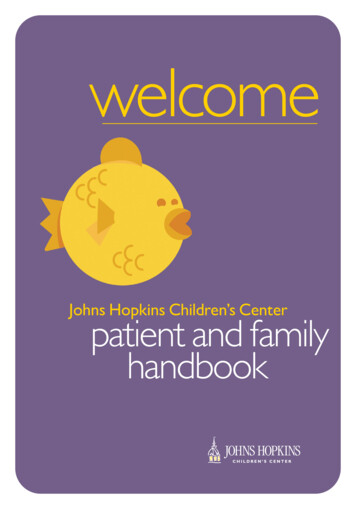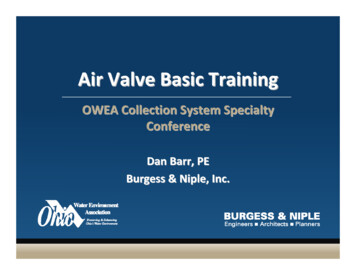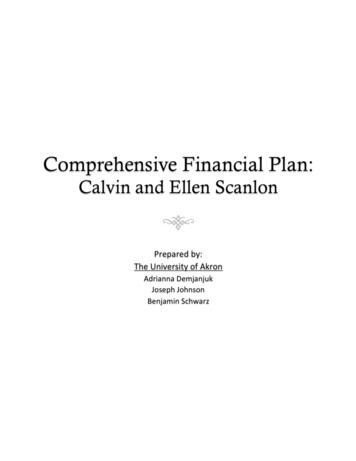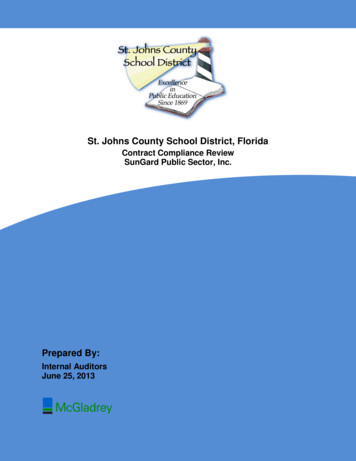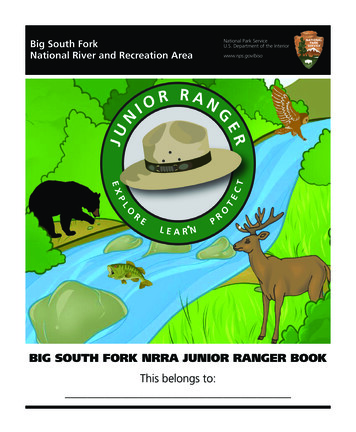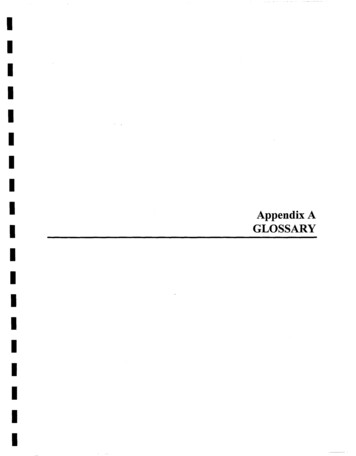
Transcription
IIIIIIIIIIIIIIIIIIIAppendix AGLOSSARY
II!IIIIIIIIIIIIIII!GLOSSARYA I R C A R R I E R - A commercial operator engaging in the carriage o f persons or property in aircommerce for compensation or hire. Air carriers are certificated in accordance with FAR Parts 121 and127, and generally operate aircraft having a seating capacity of more than 30 passengers or a maximumpayload capacity of more than 7,500 pounds.A I R R O U T E T R A F F I C C O N T R O L C E N T E R (ARTCC) - A facility established to provide positiveair traffic control service to aircraft operating on IFR flight plans within controlled airspace. Controlsonly traffic en route between airports.A I R TAXI - Schedule and/or nonscheduled aircraft operations carrying passengers and/or cargo forcompensation. The capacity of air taxi aircraft is limited by Part 135 of the Federal AviationRegulations.A I R T R A F F I C - Aircraft operating in the air or on an airport surface, excluding loading ramps andparking areas.A I R C R A F T A P P R O A C H C A T E G O R Y - A grouping of aircraft based on a speed of 1.3 times the stallspeed in the landing configuration at maximum gross landing weight. An aircraft shall fit in only onecategory. If it is necessary to maneuver at speeds in excess o f the upper limit of a speed range for acategory, the minima for the next higher category should be used. The categories are as follows:Category A - Speed less than 91 knots.Category B - Speed 91 knots or more but less than 121 knots.Category C - Speed 121 knots or more but less than 141 knots.Category D - Speed 141 knots or more but less than 166 knots.Category E - Speed 166 knots or more.A I R C R A F T M I X - The number of aircraft movements categorized by capacity group or operationalgroup, and specified as a percentage of the total aircraft movements.A I R C R A F T O P E R A T I O N - An aircraft takeoff or landing.A I R P L A N E D E S I G N G R O U P ( P H Y S I C A L C H A R A C T E R I S T I C S ) - The airplane design groupsubdivides airplanes by wingspan. The airplane design group concept links an airport's dimensionalstandards to aircraft approach categories or to airplane design groups or to runway instrumentationconfigurations. The airplane design groups are:1. Airplane Design Group I:up to but not including 49 feet.Wingspan2. Airplane Design Group II:Wingspan49 feet up to but not including 79 feet.3. Airplane Design Group I I I :Wingspan79 feet up to but not including 118 feet.4. Airplane Design Group IV:Wingspan118 feet up to but not including 171 feet.5. Airplane Design Group V:Wingspan171 feet up to but not including 197 feet.6. Airplane Design Group VI:Wingspan197 feet up to but not including 262 feet.St. Johns Industrial Air ParkA-1Draft Final Master Plan Report
IIIIIIIII!IIIIIIIIIAIRPORT ELEVATION/FIELD ELEVATION - The highest point of an airport's runways measuredin feet from mean sea level.AIRPORT LAYOUT PLAN (ALP) - A graphic presentation, to scale, of existing and proposed airportfacilities, their location on the airport, and the pertinent clearance and dimensional information requiredto show conformance with applicable standards. To be eligible for AIP funding assistance, an airportmust have an FAA-approved Airport Layout Plan.AIRPORT LIGHTING - Various lighting aids that may be installed on an airport. Types of airportlighting include:. Approach Light System/ALS: An airport lighting facility which provides visual guidanceto landing aircraft by radiating light beams in a directional pattern by which the pilot alignswith the extended centerline of the runway on his final approach for landing.Condenser-Discharge Sequential Flashing Lights/Sequenced Flashing Lights may beinstalled in conjunction with ALS at some airports. Types of Approach Light Systems are:a) ALSF-I:b)e)d)e)f)g)h)i)Approach Light System with Sequenced Flashing Lights in ILS Cat-Iconfiguration.ALSF-II: Approach Light System with Sequenced Flashing Lights in ILS Cat-IIconfiguration.SSALF: Simplified Short Approach Light System with Sequenced Flashing Lights.SSALR: Simplified Short Approach Light System with Runway Alignment IndicatorLights.MALSF: Medium Intensity Approach Light System with Sequenced Flashing Lights.MALSR: Medium Intensity Approach Light System with Runway Alignment IndicatorLights.LDIN: Sequenced Flashing Lead-in Lights.RAIL: Runway Alignment Indicator Lights (Sequenced Flashing Lights which areinstalled only in combination with other light systems).ODALS: Omnidirectional Approach Lighting System consists of seven omnidirectionalflashing lights located in the approach area of a nonprecision runway. Runway Lights/Runway Edge Lights: Lights having a prescribed angle of emission used to definethe lateral limits of a runway. Runway lights are uniformly spaced at intervals of approximately 200feet, and the intensity may be controlled or preset. Touchdown Zone Lighting: Two rows of transverse light bars located symmetrically about therunway centerline normally at 100-foot intervals. The basic system extends 3,000 feet along therunway.4. Runway Centerline Lighting: Flush centerline lights spaced at 50-foot intervals beginning 75 feetfrom the landing threshold and extending to within 75 feet of the opposite end of the runway.5. Threshold Lights: Fixed green lights arranged symmetrically left and right of the runwaycenterline, identifying the runway threshold.St. Johns Industrial Air ParkA-2Draft Final Master Plan Report
IIIIIIIIIIIIIIIIIII. R u n w a y End Identifier Lights/REIL: Two synchronized flashing lights, one on each side of therunway threshold, which provide rapid and positive identification of the approach end of a particularrunway. V i s u a l A p p r o a c h Slope l n d i c a t o r / V A S I : An airport lighting facility providing vertical visualapproach slope guidance to aircraft during approach to landing by radiating a directional pattern ofhigh intensity red and white focused light beams which indicate to the pilot that he is "on path" if hesees red/white, "above path" if white/white, and "below path" if red/red.8. P r e c i s i o n A p p r o a c h Path I n d i c a t o r / P A P I :different configuration).9.(same function and description as for VASI butB o u n d a r y Lights: Lights defining the perimeter of an airport or landing area.A I R P O R T M A S T E R PLAN - An assembly of appropriate documents and drawings covering thedevelopment of a specific airport from a physical, economical, social, and political jurisdictionalperspective. The airport layout plan is a part of this plan.A I R P O R T NOISE A B A T E M E N T P R O G R A M - A program designed to mitigate noise impactsaround an airport through changes in the manner in which aircraft are flown, or changes in the operationor layout of the airport.A I R P O R T O V E R L A Y Z O N E - A zone intended to place additional land use conditions on landimpacted by the airport while retaining the existing underlying zone.A I R P O R T R E F E R E N C E P O I N T (ARP) - An ARIP is a point having equal relationship to all existingand proposed landing and takeoff areas which is used to locate the airport geographically.A I R P O R T R E S U C E AND F I R E F I G H T I N G (ARFF) - Airport rescue and fire fighting facilities,including vehicles, personnel, and buildings.A I R P O R T R O T A T I N G BEACON - A visual NAVAID operated at many airports. At civil airports,alternating white and green flashes indicate the location of the airport.AIRSIDE - Portion of the airport directly related to the arrival and departure of aircraft, including suchairfield facilities as runways, taxiways, navigational aids, marking, and lighting. (See LANDSIDE).A I R S P A C E - Space above the ground in which aircraft travel; divided into corridors, routes, andrestricted zones.A M B I E N T NOISE - All encompassing noise associated with a given environment, being usually acomposite of sounds from many sources near and far.A N N U A L SERVICE V O L U M E (ASV) - ASV is a reasonable estimate of an airport's annual capacity.It accounts for differences in runway use, aircraft mix, weather conditions, etc., that would beencountered over a year's time.A P P R O A C H AND R P Z P L A N - The Approach and RPZ Plan is compiled from the criteria in FARPart 77, Objects Affecting Navigable Airspace. It shows the area affected by the Airport ObstructionsSt. Johns Industrial Air ParkA-3Draft Final Master Plan Report
IIIIIII!IIIIIIIIII!Zoning Ordinance and includes layout of runways, airport boundary, elevations, and area topography.Applicable height limitation areas are shown in detail.SLOPES- The ratios of horizontal to vertical distance indicating the degree of inclinationof the Approach Surface. The various ratios include:APPROACH20:1For all utility and visual runways extended from the primary surface a distanceof 5,000 feet.34:1For all nonprecision instrument runways other than utility extended from theprimary surface for a distance of 10,000 feet.50:1/40:1For all precision instrument runways extending from the primary surface for adistance of 10,000 feet at an approach slope of 50:1 and an additional 40,000feet beyond this at a 40:1 Approach Slope.An element of the airport imaginary surfaces longitudinally centered on theextended runway centerline, extending outward and upward from the end of the primary surface at adesignated slope.APPROACHSURFACE-An instrument approach approved for general use andpublication by the FAA. It must meet design, accuracy, and equipment requirements set by the FAA,and is subject to periodic FAA flight checks.APPROVEDINSTRUMENTAPPROACH-An area designated for aircraft use, other than taxiways and runways. Example usesfor an apron include loading and unloading, parking, maintenance, refueling, before take-off enginerunup, and as a temporary traffic holding area.APRON/RAMP-AREA N A V I G A T I O N ( R N A V ) - A method of navigation that permits aircraft operation on any desiredcourse within the coverage of station-referenced navigation signals or within the limits o f a selfcontained system capability.A U T O M A T I C D I R E C T I O N FINDER (ADF) - An aircraft radio navigation system which senses andindicates the direction to a nondirectional radio beacon (NDB) ground transmitter. Direction is indicatedto the pilot as a magnetic bearing or as a relative bearing to the aircraft, depending on the type ofindicator installed in the aircraft.A V I G A T I O N AND H A Z A R D EASEMENT - An easement which provides right of flight at anyaltitude above the approach surface, prevents any obstruction above the approach surface, provides aright to cause noise vibrations, prohibits the creation of electrical interference's and grants right-of-wayentry to remove trees or structures above the approach surface.BASED A I R C R A F T - An aircraft permanently stationed at an airport.BUILDING R E S T R I C T I O N LINE (BRL) - A line shown on the Airport Layout Plan beyond whichairport buildings must not be positioned in order to limit their proximity to aircraft movement areas.C A P A C I T Y - Capacity (throughput capacity) is a measure of the maximum number o f aircraftoperations which can be accommodated on the airport component in an hour. Since the capacity o f anSt. Johns Industrial Air ParkA-4Draft Final Master Plan Report
IIIIIIIIIIIIIIIIIIIairport component is independent of the capacity of other airport components, it can be calculatedseparately.C O M M E R I C A L S E R V I C E - Commercial service airports are public-use airports which receivescheduled passenger service aircraft and which annually enplane 2,500 or more passengers.C O M M U T E R A I R C A R R I E R - An air carrier, certificated in accordance with FAR Part 135, whichoperates aircraft with a maximum of 60 seats and provides at least five schedule round trips per weekbetween two or more points, or which carries mail.C O M P R E H E N S I V E P L A N - A set of public decisions dealing with how the land, air, and waterresources of an area are to be used. The plan provides for all resources, uses, public facilities, andservices in an area. It also incorporates the plans and programs of the various governmental units into asingle management tool for the planning area.USEA land use regulatory procedure in which an applicant must adhere to"standards for approval" as established by local officials. A conditional-use procedure allows extensivepublic review of any development being considered.CONDITIONALCONTROLLEDAIRSPACE- An airspace of defined dimensions which air traffic control service isprovided to IFR flights and to VFR flights in accordance with the airspace classification.a.Controlled airspace is a generic term that covers Class A, Class B, Class C, Class D andClass E airspace.b.Controlled airspace is also that airspace within which all aircraft operators are subject tocertain pilot qualifications, operating rules and equipment requirements in FAR Part 91(for specific operating requirements, please refer to FAR Part 91). For IFR operations inany class of controlled airspace, a pilot must file an IFR flight plan and receive anappropriate ATC clearance.Each Class B, Class C and Class D airspace areadesignated for an airport contains at least one primary airport around which the airspaceis designated (for specific designations and descriptions of the airspace classes, pleaserefer to FAR Part 71).c.Controlled airspace in the United States is designated as follows:.CLASS A: Generally, that airspace from 18,000 feet MSL up to and includingFL 600, including the airspace overlying the waters within 12 nautical miles ofthe coast of the 48 contiguous States and Alaska. Unless otherwise authorized,all persons must operate their aircraft under IFR.CLASS B: Generally, that airspace from the surface to 10,000 feet MSLsurrounding the nation's busiest airports in terms of airport operations orpassenger enplanements. The configuration of each Class B airspace area isindividually tailored and consists of a surface area and two or more layers (someClass B airspace areas resemble upside-down wedding cakes) and is designed tocontain all published instrument procedures once an aircraft enters the airspace.An ATC clearance is required for all aircraft to operate in the area, and allSt. Johns Industrial Air ParkA-5Draft Final Master Plan Report
IIIIIIIIIIIIIIIIIIIaircraft that are so cleared receive separation services within the airspace. Thecloud clearance requirement for VFR operations is "clear of clouds.".CLASS C: Generally, that airspace from the surface to 4,000 feet above theairport elevation (charted in MSL) surrounding those airports that have anoperational control tower, are serviced by a radar approach control, and that havea certain number of IFR operations or passenger enplanements. Although theconfiguration of each Class C area is individually tailored, the airspace usuallyconsists of a surface area within a 5 nautical mile (NM) radius, an outer circlewith a 10NM radius that extends from 1,200 feet to 4,000 feet above the airportelevation and an outer area. Each person must establish two-way radiocommunications with the ATC facility providing air traffic services prior toentering the airspace and thereafter maintain those communications while withinthe airspace. VFR aircraft are only separated from IFR aircraft within theairspace. (See OUTER AREA.).CLASS D: Generally, that airspace from the surface to 2,500 feet above theairport elevation (charted in MSL) surrounding those airports that have anoperational control tower. The configuration of each Class D airspace area isindividually tailored and when instrument procedures are published, theairspace will normally be designed to contain the procedures. Arrival extensionsfor instrument approach procedures may be Class D or Class E airspace. Unlessotherwise authorized, each person must establish two-way radio communicationswith the ATC facility providing air traffic services prior to entering the airspaceand thereafter maintain those communications while in the airspace. Noseparation services are provided to VFR aircraft.CLASS E: Generally, if the airspace is not Class A, Class B, Class C or Class D,and it is controlled airspace, it is Class E airspace. Class E airspace extendsupward from either the surface or a designated altitude to the overlying oradjacent controlled airspace. When designated as a surface area, the airspacewill be configured to contain all instrument procedures. Also in this class areFederal airways, airspace beginning at either 700 or 1,200 feet AGL used totransition to/from the terminal or en route environment, en route domestic andoffshore airspace areas designated below 18,000 feet MSL. Unless designated ata lower altitude, Class E airspace begins at 14,500 MSL over the United States,including that airspace overlying the waters within 12 nautical miles of the coastof the 48 contiguous States and Alaska, up to, but not including, 18,000 feetMSL and the airspace above FL 600.C O N V E N T I O N A L H A N G A R - A large building used to store more than one aircraft and/or to conductaircraft maintenance.C R I T I C A L A I R C R A F T - In airport design, the aircraft which controls one or more design items suchas runway length, pavement strength, lateral separation, etc., for a particular airport. The same aircraftmay not be critical to all design items.A runway additional to the primary runway to provide for wind coveragenot adequately provided by the primary runway.CROSSWINDRUNWAY-St. Johns Industrial Air ParkA-6Draft Final Master Plan Report
IIIIIIIIIIIIIIIIIIIDECISION H E I G H T ( D I t ) - With respect to the operation of aircraft, DH means the height at which adecision must be during an ILS instrument approach to either continue the approach or to execute amissed approach.DEPENDENT VARIABLE - The variable that is of interest to the researcher; the variable that is notforecast. In regression analysis, the variable on the left-hand side of the equation.DISPLACED THRESHOLD - A threshold located at a point on the runway other than at the runwayend. Except for the approach standards defined in FAR Part 77, approach surfaces are associated withthe threshold location.DISTANCE MEASURING EQUIPMENT ( D M E ) - A navigation ground station capable of receivinginterrogations from aircraft and transmitting signals which allow time, speed, and distance computationsto be made. The station is usually sited with VOR and, at times, an ILS.EASEMENT - The legal right held by one party to make use of the land of another for a limitedpurpose.E C O N O M E T R I C METHODS - Regression correlation techniques applied to a great variety offorecasting problems to ascertain the relationships between the dependent variables and such explanatoryand logically relevant economic variables as income, demographic variables such as population, andother market factors, such as usage impedance and intermodal competition. (See Regression Equation).ENVIRONMENTAL ASSESSMENT (EA) - A concise public document, prepared under theguidelines of the National Environmental Policy Act of 1969, and for which a federal agency isresponsible that serves to:1. Briefly provide sufficient evidence and analysis for determining whether to prepare anenvironmental impact statement or a finding of no significant impact.2. Aid an agency's compliance with the Act when no environmental impact statement isnecessary.3.Facilitate preparation of a statement when one is necessary.It includes brief discussions of the need for the proposal, of alternatives as required, of the environmentalimpacts of the proposed action and alternatives, and a listing of agencies and persons consulted.FEDERAL AVIATION REGULATIONS (FAR), PART 36FAR Part 36 contains noisecertifications standards for most airplane types, generally requiring newly designed and manufacturedaircraft to be significantly quieter than older aircraft.FEDERAL AVIATION REGULATIONS (FAR), PART 7 7 - Part 77, O b j e c t sA i r s p a c e , establishes standards for determining obstructions to navigable airspace.AffectingNavigableFEDERAL AVIATION REGULATIONS (FAR), PART 150 - Implements portions of Title I of theAviation Safety and Noise Abatement Act. It specifically establishes a single system for theSt. Johns Industrial Air ParkA-7Draft Final Master Plan Report
IIIIIIIIIIIIIIIIIIImeasurement of airport (and background) noise, a single system for determining the exposure ofindividuals to airport noise, and a standardized airport noise compatibility planning program.FIXED BASE O P E R A T O R (FBO) - A private firm providing airport services such as fuel sales,aircraft maintenance, aircraft rental, and flight instruction.F L I G H T S E R V I C E S T A T I O N (FSS) - A facility operated by the FAA to provide flight serviceassistance.G E N E R A L A V I A T I O N (GA) - The portion of civil aviation which includes all facets of aviationexcept scheduled air carriers.G E N E R A L A V I A T I O N A I R P O R T - General Aviation airports are either publicly or privately ownedairports which serve general aviation aircraft users.GLIDE SLOPEProvides vertical guidance for aircraft during approach and landing. The glideslope consists of the following:( G S )-1. Electric components emitting signals which provide vertical guidance by reference toairborne instruments during instrument approaches such as an ILS, or2.Visual ground aids, such as VASI, which provide vertical guidance for a VFR approach orfor the visual portion of an instrument approach and landing.H E I G H T A B O V E T O U C H D O W N (HAT) The height of the decision height or minimum descentaltitude above the highest runway elevation in the touchdown zone (first 3,000 feet of the runway). HATis published on instrument approach charts in conjunction with all straight-in minima. (See DECISIONHEIGHT, MINIMUM DESCENT ALTITUDE).-HELl-PAD - A small, designated area, usually with a prepared surface, on a heliport, airport,landing/takeoff area, apron/ramp, or movement area used for takeoff, landing, or parking of helicopters.HOLD HARMLESS AGREEMENTAn agreement which holds airport sponsors or jurisdictionsharmless from alleged damages resulting from airport operations. Such agreements are recorded indeeds or permits as a condition of approval of a regulatory land-use decision.-1FR C O N D I T I O N S - Weather conditions below the minimum for flight under visual flight rules (VFR).I M A G I N A R Y S U R F A C E S - Those areas established in relation to the airport and to each runwayconsistent with FAR Part 77 in which any object extending above these imaginary surfaces is, bydefinition, an obstruction.I N D E P E N D E N T V A R I A B L E An indicator on the basis of which the dependent variable is projected.The Independent Variable may or may not cause the interval change in a dependent variable with whichit is associated.-I N S T R U M E N T A P P R O A C H - The act of making an approach to an airport solely by reference toinstruments. To be counted in FAA statistics as an instrument approach, the aircraft must descendthrough clouds at some interval from the initial approach fix to the airport.St. Johns Industrial Air ParkA-8Draft Final Master Plan Report
IIiiII!IIIIIIIIIIIiINSTRUMENT A P P R O A C H AID - Any of several FAA-approved electronic aids designed to provideguidance to pilots making instrument approaches.INSTRUMENT F L I G H T RULES (IFR) - Rules governing the procedures for conducting instrumentflight. Pilots are required to follow theses rules when operating in controlled airspace with a visibility ofless than three miles and/or a ceiling lower than 1,000 feet.INSTRUMENT LANDING SYSTEM (ILS) - The instrument landing system is designed to provideelectronic instrument guidance to the pilot to permit exact alignment and angle of descent of a properlyequipped aircraft on final approach for landing.INSTRUMENT O P E R A T I O N - A takeoff or landing of an aircraft which has an instrument flightclearance.INTEGRATED NOISE MODEL (INM)The FAA's Integrated Noise Model is the standardprediction analysis tool to which all computer-based airport noise exposure models are compared. TheINM calculates the total impact of aircraft noise at or around airports. This noise exposure level can bepresented in contours of equal noise exposure of any one of the following noise measures. NoiseExposure Forecast (NEF), Equivalent Sound Level (Leq), Day-Night Average Sound Level andCommunity Noise Equivalent Level (CNEL); however, only the DNL is approved for use with FAR Part150.-ITINERANT OPERATIONSLOCAL OPERATIONS).All operations at an airport which are not local operations.-(SeeLANDING GEAR That part of an aircraft which is required for landing. Gear may be configured asSingle-Wheel Gear (SWG or SW), Dual-Wheel Gear (DWG or DW), or Dual-Tandem-Wheel Gear(DTWG or DTW).-LANDSIDE - Portions of the airport interfacing with or supporting the airfield functions, including suchfacilities as terminal area buildings, aircraft parking apron, automobile parking area, fuel storage, aircargo, and ground access. (See AIRSIDE).LAND USE - The present or planned utilization of a given parcel of land. Such land uses are normallyindicated or delineated on a land-use map. Land-use maps may indicate usage's for any given timeperiod past, present, or future, and such period should always be indicated.LARGE AIRCRAFT - Aircraft of more than 12,500 pounds maximum certificated takeoff weight.LIGHTING AND MARKING OF HAZARDS TO AIR NAVIGATION - Installation of appropriatelighting fixtures, painted markings, or other devices to such objects or structures that constitute hazardsto air navigation.LIMITED AVIGATIONAn easement which provides right of flight above approachslope surfaces, prohibits any obstruction penetrating the approach slope surface, and provides right ofentry to remove any structure or growth penetrating the approach slope surface.ESt. Johns Industrial Air ParkASEMENT-A-9Draft Final Master Plan Report
IIIIIIIIIIIIIIIIIIIOPERATIONS- Operations by aircraft flying in the traffic pattern or within sight of thecontrol tower, aircraft known to be arriving or departing from flight in local practice areas, or aircraftexecuting practice instrument approaches at the airport.LOCALL O C A L I Z E R - The component of an ILS which provides course guidance to the runway.L O R A N - An electronic navigational system by which hyperbolic lines o f position are determined bymeasuring the difference in the time of reception of synchronized pulse signals from two fixedtransmitters.M A R K E T SHARE ANALYSIS - Proportions a large-scale activity down to a local level, assuming thatthe proportion of the large-scale activity which can be assigned to the local level is a regular andpredictable quantity. Also known as "ratio" or "top-down" modeling, this method is commonly used todevelop micro forecasts from the exogenous sources of macro forecasts.A R E A - The runways, taxiways, and other areas of an airport/heliport which are utilizedfor taxiing/hover taxiing, takeoff, and landing of aircraft, exclusive of loading ramps and parking areas.At those airports/heliports with a tower, specific approval for entry onto the movement area must beobtained from ATC.MOVEMENTA advanced form of precision approach equipment withimproved accuracy and fewer siting problems than current ILS. An MLS also can permit curved pathapproaches to the runway instead of requiring a straight path as an ILS and PAR do.MICROWAVELANDINGSYSTEM(MLS)-DESCENTALTITUDE( M D A ) - The lowest altitude, expressed in feet above mean sealevel, to which descent is authorized on final approach or during circle-to-land maneuvering in executionof a standard instrument approach procedure where no electronic glide is provided.(SeeNONPRECISION APPROACH PROCEDURE).MINIMUMMISSEDAPPROACH-. A maneuver conducted by a pilot when an instrument approach cannot be completed to alanding. The route of flight and altitude are shown on instrument approach procedure charts.A pilot executing a missed approach prior to the Missed Approach Point (MAP) mustcontinue along the final approach to the MAP. The pilot may climb immediately to thealtitude specified in the missed approach procedure.2.A term used by the pilot to inform ATC that he is executing the missed approach.3.At locations where ATC radar service is provide, the pilot should conform to radar vectors,when provided by ATC, in lieu of the published missed approach procedure.M U L T I - E N G I N E A I R C R A F T - Reciprocating-powered, fixed-wing aircraft having more than oneengine and categorized as weighing more than or less than 12,500 pounds maximum gross weight.MULTIPLEREGRESSION-A regression model with more than one independent variable.REGRESSION EQUATION).St. Johns Industrial Air ParkA-IODraft Final Master Plan Report(See
IIIIIIIIIIIIIIIIIIIN A T I O N A L PLAN O F I N T E G R A T E D A I R P O R T S Y S T E M S ( N P I A S ) - A plan prepared annuallyby the FAA which identifies, for the Congress and the public, the composition of a national system ofairports together with the airport development necessary to anticipate and meet the present and futureneeds o f civil aeronautics, to meet requirements in support of the national defense, and to meet thespecial needs of the Postal Service. The plan includes both new facilities and qualitative improvementsto existing airports to increase their capacity, safety, technological capability, etc.N A V I G A T I O N A L AID (NAVAID) - Any visual or electronic device airborne or on the surface whichprovides point-to-point guidance information or position data to aircraft in flight.- A noise impact boundary line connecting places on a map where the level ofsound is the same. Some of the terminology and methods used in developing noise contours include:NOISE CONTOURS1. A-Weighted S o u n d L e v e l (I)BA):Co
RAIL: Runway Alignment Indicator Lights (Sequenced Flashing Lights which are installed only in combination with other light systems). ODALS: Omnidirectional Approach Lighting System consists of seven omnidirectional flashing lights located in the approach area of a nonprecision runway. . Runway Lights/Runway Edge Lights: Lights having a .
